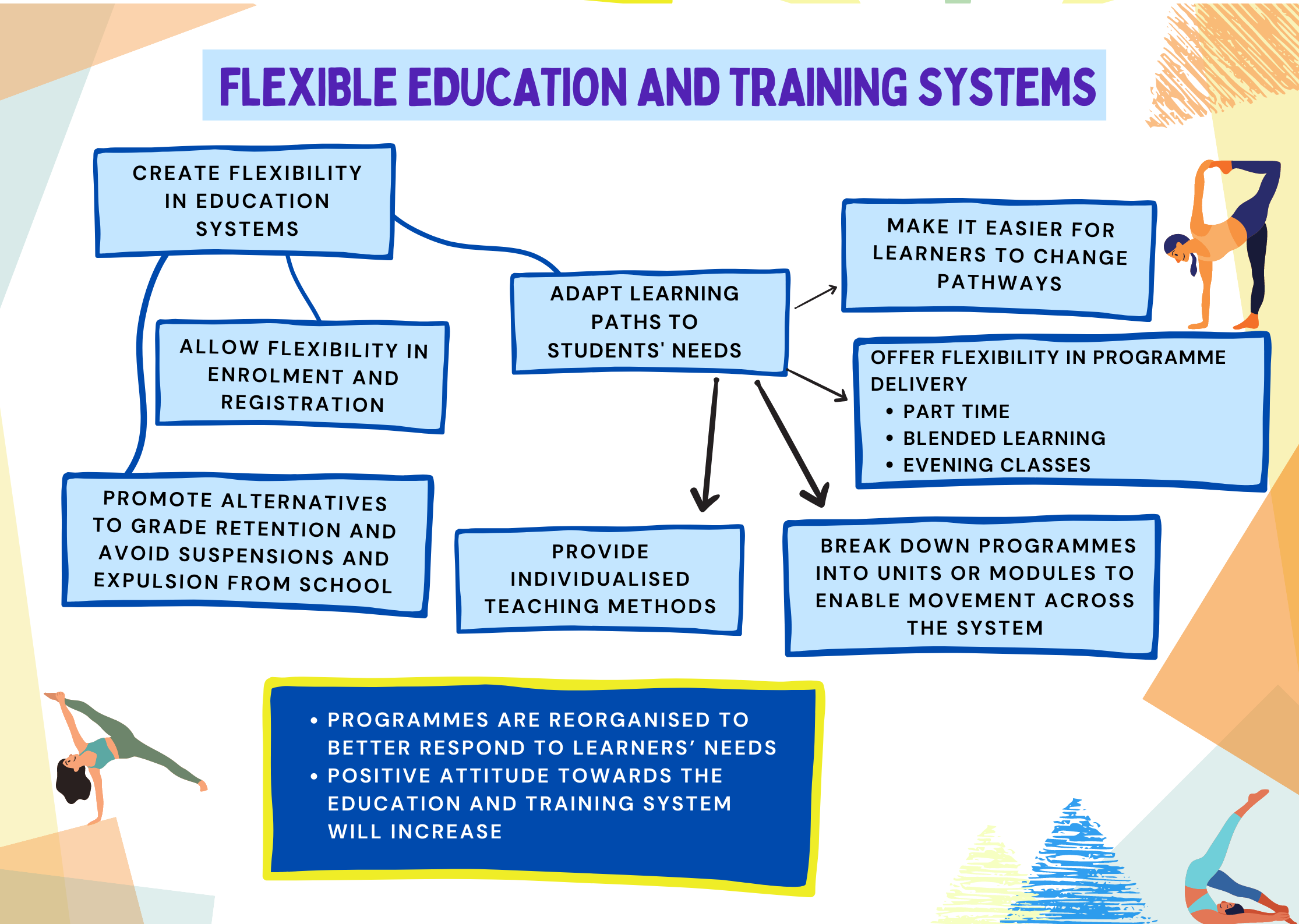Problem statement
Addressed problem: Providing choices, not closing doors
- Flexible education systems enable learners to move within and across education, training and employment. Flexibility means that young people can adapt their learning pathway as they go along, to suit their interests and abilities.
In systems that lack flexibility, it is difficult for young people to make transitions from one learning pathway to another. They may find that they are restricted to their original choice, even if they have realised that this choice isn’t right for them. This can be a factor leading them to dropping out.
Repetition of learning can also be demotivating for young people. Learners who are able to switch courses, but are required to start from the beginning, can be discouraged by the need to repeat content they have already covered in their previous course.
Flexibility in the delivery and timing of learning opportunities means that young people who have other demands on their time can continue to work towards their chosen qualification, or can return to learning if they have already dropped out.
Young people facing barriers to learning or who have had to interrupt their education may benefit from an extended period to complete their studies, the possibility to attend courses on a part-time basis, or an alternative teaching method (e.g. online learning).
- The systematic use of grade retention as a means to reduce the educational delay of low-achieving pupils, and of suspension or expulsion from school as disciplinary measures for students with behavioural problems, leads to more early leaving.
Students who repeat grades have higher chances of dropping out, generally do not improve performance, and have a more negative attitude towards school than non-repeaters. Suspended students are more likely to drop out, to misbehave again, and to have poor academic performance. Also, there are strong links between school exclusion and social exclusion.
- Permeability means that young people can progress to programmes at higher level and take forward their long-term career, regardless of the pathway they have chosen.
If systems are not permeable, it can be difficult for young people to progress, for example from Vocational Education and Training (VET) to higher education (HE). This can be a barrier to long-term career progression. It can also reinforce negative perceptions of VET as a ‘second class’ option to general education.
People who have dropped out of education before completing lower or upper secondary education can find it hard to return. They may not meet the entry requirements for available courses, or there can be a lack of lower secondary programmes for adults.

Beneficiaries
All young people can benefit from flexibility and permeability in education and training systems. It is important for students who would like to change to a different programme, and for young people who are looking for an opportunity to re-enter the system. Young people facing external barriers to learning (e.g. they need to work to support their families or have caring responsibilities) may also need flexibility in the way a course is delivered.
Poor school performance and inappropriate behaviour are often associated with disadvantaged socio-cultural backgrounds. Measures that prevent or avoid repetition, suspension or expulsion can be particularly important for students from disadvantaged backgrounds.
Addressing the problem
Tips: Creating flexibility in education systems
More flexible and permeable VET pathways can be achieved in a variety of ways. These include breaking down programmes into units or modules to enable movement across the system, offering opportunities for credit transfer or recognition of prior learning, introducing the possibility to attend evening classes or attend courses on a part-time basis, and individualised teaching methods.
The following tips are given as advice to policy-makers and practitioners involved in the design and delivery of such measures. The information is based on Cedefop research into successful measures.
It should be possible, and simple, for learners to move across to a different programme. Learners should not have to repeat any curriculum content they have already completed. Repetition can be avoided in systems where programmes are broken down into modules or units (see below), through credit transfer or recognition of prior learning.
Modularisation or partial certification enables learners to certify their skills gradually. Modular assessment may help to motivate individuals with low self-confidence; there is a sense of achievement each time a module is completed. It may be appealing to young people who may have previous negative experiences of single, end-of-year exams. It can also be a positive option for young people who have already left education early, as it means they can ‘fill the gaps’ in their skills, rather than having to repeat a full course.
Grade retention should only be used in exceptional circumstances. It is important to assess the benefits of repetition and of alternative measures, on a case by case basis. Parents and students should be involved in the decision on grade repetition. Also, students must not be simply held back. To ensure that repetition has a positive impact on students, there need to be specific measures in place to promote achievement and social skills of repeaters.
Alternatives to grade retention include for instance:
- One-on-one or small group support, tutoring or counselling
- Cooperative learning, peer tutoring
- Support with homework, e.g. school’s homework club, support by university students
- Parental involvement, e.g. development of routines and time management for homework and out of school activities
- Establishment of positive teacher-pupil relationships
- Organisational measures such as grouping students by level of achievement in certain subjects, multi-age grouping, or smaller class groups
- Participation in extracurricular activities to increase motivation
- Increase of instructional time at school, out of school or during summer breaks
Alternatives to grade retention can be promoted at system level by giving schools autonomy to adapt curricula and assessment to individual needs.
Serious behavioural offences may require a student to be excluded from school. Suspension or expulsion should be used in very limited circumstances, and follow the careful consideration of alternative measures, such as:
- Counselling and onsite support with multidisciplinary teams.
- Short courses to promote social skill development, conflict resolution, and behavioural change. These can address specific topics such as discrimination, sexual harassment, alcohol/drug use, inappropriate language or other.
- Parental involvement, including better communication between school and parents and coordinated approach to behaviour change.
- Behaviour contracts that specify expected behaviour, consequences of misbehaviour and incentives for appropriate behaviours. These contracts should be negotiated with the student.
- Behaviour monitoring which can involve the use of behaviour checklists for students, parents and teachers, and feedback sessions focusing on positive behaviour when it occurs.
- Restitution, such as an oral or written apology or the participation in activities to clean and improve the school environment.
In-school suspension should be preferred to out-of-school suspension and expulsion. It should be combined with measures to promote behavioural change and allow the student to continue academic instruction. Procedures must link improved behaviour and return to the regular classroom, and be clear for student and staff. VET schools and the education system should also promote prevention measures to reduce the use of suspension and expulsion. This includes introducing early warning systems to identify at-risk students (e.g. low attendance, declining grades) and explore issues with students before they become discipline problems. It is also important to promote a positive school climate.
It is important that young people who have left the education and training system can return to mainstream education. This includes learners who have taken part in second chance or compensatory measures.
Maintaining links between these alternative opportunities and mainstream education is key to giving all learners the chance to complete upper secondary education. This includes finding ways to recognise the learning outcomes achieved through second chance and compensatory measures and tackling negative perceptions of this type of provision.
VET should not be a closed path. Possibilities to pursue further lifelong learning opportunities should be available to all learners. Routes into higher education from VET should be possible. Deeper collaboration between VET and higher education providers should be promoted to ensure successful transitions.
Strict enrolment conditions and registration deadlines can be a barrier to participation in VET. Young people who are waiting for the results of their initial education, may apply to a programme and then not be able to access it due to not attaining the required grades. It is important to keep enrolment and registration open long enough to allow such students to apply to other programmes. This can help avoid drop-out in periods of transition between education levels.
For early leavers who decide to return to learning, offering opportunities to do so mid-way through the term or year reduces the risk that they will move on to other things (e.g. a new job) by the time the next academic year begins.
Part-time, distance or blended learning (combination of online learning and traditional face-to-face instruction) opportunities can be helpful for young people who face external barriers to learning. For example, young people who have caring responsibilities or who are in employment may be able to complete their qualification through evening classes or online learning.
Guidance and counselling should help learners develop career management skills and choose the right pathway from the very beginning. It can help those young people who are struggling with the path they have chosen, to decide how to move forward. And it can help those who left school, to find a pathway back to it. Integrating, or ensuring strong links between, guidance and counselling services provided by the education and employment sectors for both initial and continuing VET could help support flexible learning pathways.
Young people may just need an opportunity to re-assess their situation and identify a way forward. One way of doing this is through the use of a portfolio or skills audit approaches. Identifying and recognising learners’ existing skills, then building on these through individual learning plans and pedagogies may mean they do not need to repeat curriculum content in their new pathway.
See: One-to-one support through coaching or mentoring
Validating non-formal and informal learning can also help young people who have acquired skills outside of formal education, for instance through employment. By identifying and validating existing skills (through credit or a certificate), it can help young people return to education and receive qualification.
Expected outcomes
Flexible and permeable education and training systems can have the following outcomes at different levels:
| INDIVIDUAL | INSTITUTIONAL | SYSTEM |
|---|---|---|
|
|
|


